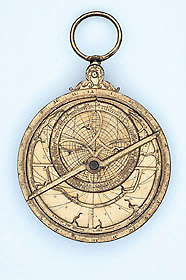
 |
| Catalogue |
 |
 Astrolabe Suspension is by means of a throne (with three decorated lobes), shackle and ring. The rete has 13 flambent star pointers, all named. The ecliptic is divided into 360?, divided to 10? and to 2?, numbered from [0?] to 30? by 10?. Every zodiac sign is named in abbreviated form. Inside the ecliptic, which is linked with two ties and with the east-west line to the Capricorn band, is a sort of three-leaf decoration. The two plates are marked for latitudes 51?34', 53?, 54? and 55?. They are all engraved with east-west and meridian lines, both tropic and equator lines, almucantars every 5? (numbered from 5? to 65? every 5?) and azimuth lines (numbered from 10? to 90? every 10?), unequal hour lines (numbered 1 to 12) and astrological house lines, dotted and numbered 1 to 12. The rim of the limb is inscribed '1659 ? Acad ? Oxon ? Ex dono Nic Greaves ? S?T?D?' The back of the mater has on the rim a scale of degrees divided into four quadrants of 90? with 90? at the zenith, divided to 10?, to 2?, numbered by 10?. Further to the centre is a calendar scale with the abbreviated names of the zodiacal signs, sharing the division in degrees of the outer scale and numbered from [0?] to 30? by 10?. Further to the centre is a calendar scale (the first point of Aries is on 11 March) with the names of the months abbreviated, divided to the day, and the 10th, 20th and last day numbered. Next to the centre are, on the top half, two diagrams with equal and unequal hour lines with a sun effigy in the centre, and on the bottom half a double shadow square divided to 3 and subdivided to 1, numbered by 3. The alidade is counterchanged and its arms, ending in a Gothic style, are lined on the borders. The two sighting vanes have one hole each. The two-armed rule is counterchanged and ends in Gothic style. The wedge is a very thin nail and the pin is simple. Ilaria Meliconi |



